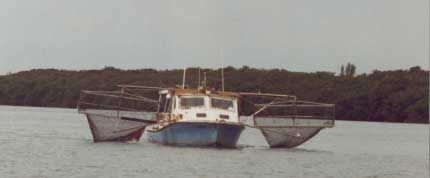
|
Our subscribe page has moved! Please visit baysoundings.com/subscribe to submit your subscription request. |
|||

|
||||
Navigating At NightBig ships are marvels to behold. They stir the soul and pique the imagination, beckoning those with a thirst for adventure. And nothing is more enchanting than a ship at night, all lit up against a star-strewn sky, says bay pilot John Timmel, who guides tankers and cruise ships in and out of Tampa Bay.
One of about 40 licensed bay pilots assigned to Tampa Bay, Timmel and other specially trained navigators board incoming ships a mile out to sea and outgoing vessels at port, guiding them through the bay's narrow channels. Bay pilots carry portable navigation units that use electronic charts and differential GPS (sophisticated satellite positioning technology) to pinpoint vessel locations within two to three feet, tracking changes within seconds. Navigating these floating behemoths in tight quarters requires skill and in-depth knowledge of local conditions. Some of the largest ships entering Tampa Bay are longer than 950 feet, twice as long as Tampa's tallest skyscraper. The giant cruise ship Sensation is 855 feet, just shy of the length of three football fields. As many as a dozen ships arrive or depart on any given night. Cruise ships generally take two hours to navigate the channel, and there are no bail-out or passing zones. Shipping lanes are dredged to depths of up to 43 feet, and narrow to 200 feet in some places. Stopping mid-course isn't a practical option: bringing a deep-loaded tanker to a halt can take a mile or more from an average speed of just 12 knots (about 14 mph). That makes thinking ahead critical. But traffic is generally light and the views are spectacular. "We forget how many stars are out at night," says Timmel, "and then we get away from shore and the sky suddenly fills up." Visitors also are enthralled. Bay pilots are ambassadors of sorts, greeting crews from all over the world. "A lot of times you'll be the first person they've seen in weeks and their first impression of what Americans are truly like. We bring them a newspaper·we bring them into the bay, and you can feel a sense of excitement the closer you get to port." "It's almost like you're entering Oz." |
||||
MoonlightingBait shrimper Ken Hartley has worked the grass flats around Fort DeSoto after dark for more than 20 years, while holding a day job at Honeywell in Clearwater. Now semi-retired, he hitches an occasional ride with buddies still in the business, and reflects on the nightlife that kept him water-bound for so long. "It's a whole different world out there at night, how you get around and how you learn to come home," says Hartley.
On any given night about a half dozen boats leave O'Neal's Marina near the Skyway Bridge to trawl for bait shrimp, spending anywhere from two to 10 hours on the water, as long as it takes to make the catch. A good haul might be 15,000 or more shrimp, with 10,000 a night about average. The shallow-draft boats are specially outfitted with 10-foot-wide roller trawls that comb the grassy bottom on each side, pulling in nets every 10 minutes or so, and catching anywhere from 1,000 to 6,000 shrimp an hour. The shrimp are transported back to the dock in aerated tanks, then delivered live by truck to bait shops before 6 a.m.
Most nights the water's very calm, making the tough work enjoyable, but foggy nights "when you can't see past the front of the boat and you know you have to keep working to get the catch" are dreadful. Still it's the challenge, never knowing what you'll confront, and the unforgettable sights - like propeller wash and nets aglow in a blue-white flame of tiny bioluminescent organisms, or a rocket launch against a jet black sky - that keep Hartley and other night fishers coming back. The hardy "do it yourselfers" are a unique brand of individuals, competitive but close. "If you need something for one of your boats, you can't go to the hardware store," muses Hartley. "You got to make it yourself." But that rugged individualism doesn't override an unwritten code of honor among shrimpers. "If you get in trouble, somebody always helps you out, even if they don't like you much." |
||||
Listening In On BatsIt's just after dusk and big hunks of mosquito bait - all five of us - are huddled in the back of a battered pick-up truck. Bouncing along in the dark, George Marks trains his eyes on the luminous glow of a computer screen while raising a microphone into the night sky. The bat detector picks up the first call at 6:21 p.m. The stealth creature, a Brazilian free-tailed bat traveling at 35 to 40 mph, emits an increasingly rapid series of high-pitched calls - inaudible to the human ear but captured by our equipment - before snatching its prey.
Bat fanciers George and Cyndi Marks record their night chatter using equipment that picks up and digitizes the high-frequency calls, then converts them into audible clicks and downloads the sound patterns onto a laptop computer. Plotted onscreen, the calls form specific patterns that reveal the species making them. The husband-and-wife team conducts acoustical bat surveys throughout the state on behalf of the Port Charlotte-based Florida Bat Center (FBC). Their digital catalog now numbers in the thousands, documenting nine different species. The surveys help determine the range of bat species so they can advise residents and communities on ways to conserve these beneficial creatures. Tonight's off-road expedition takes us by several ponds and giant mud puddles at the Terra Ceia Buffer Preserve on Tampa Bay's southeastern shore. Buggiest right after sunset, bat activity (and mosquito bites) surge in our first hour. We record about a dozen calls, documenting several of the region's most common residents: the diminutive evening bat and the free-tailed bat. And with a quick flick of a flashlight, we catch a fleeting glimpse of a rare big brown bat zooming overhead. Bats use sonar to maneuver and hunt in the dark. "The animal itself is so incredible," says George Marks, an electrical engineer by training, whose fascination with the world's only flying mammal continues to grow. Certain species are dwindling as development encroaches, but positive buzz on these amazing mammals is rising along with efforts to protect them and provide suitable habitat. Solitary roosters - like the yellow bat and Seminole bat, which roost in dead palm fronds and Spanish moss - are most at risk as lands are cleared. Colonial nesters like the free-tailed and evening bats, which prefer structure and often roost in buildings, are more abundant. See the Kid's Corner to learn more, including tips on building or purchasing your own backyard bat house.
|
||||
 More than half of the bay's shipping traffic occurs after dark. Cruise ships typically arrive after midnight so passengers awaken at port. Cargo ships dock before daylight so longshoremen coming on duty in the morning can begin offloading immediately.
More than half of the bay's shipping traffic occurs after dark. Cruise ships typically arrive after midnight so passengers awaken at port. Cargo ships dock before daylight so longshoremen coming on duty in the morning can begin offloading immediately.
 Working the night shift, Hartley has seen plenty of small sharks, sea turtles, and file fish, as well as the menacing scorpion fish, a seasonal visitor. Just a tiny poke from its dorsal fin hurts worse than the better known catfish. Rules dictating where and how bait shrimpers fish, designed to protect the fishery and limit unintentional by-catch, plus competition from bigger boats up in the Panhandle, have driven scores of boats off the bay, Hartley says.
Working the night shift, Hartley has seen plenty of small sharks, sea turtles, and file fish, as well as the menacing scorpion fish, a seasonal visitor. Just a tiny poke from its dorsal fin hurts worse than the better known catfish. Rules dictating where and how bait shrimpers fish, designed to protect the fishery and limit unintentional by-catch, plus competition from bigger boats up in the Panhandle, have driven scores of boats off the bay, Hartley says.